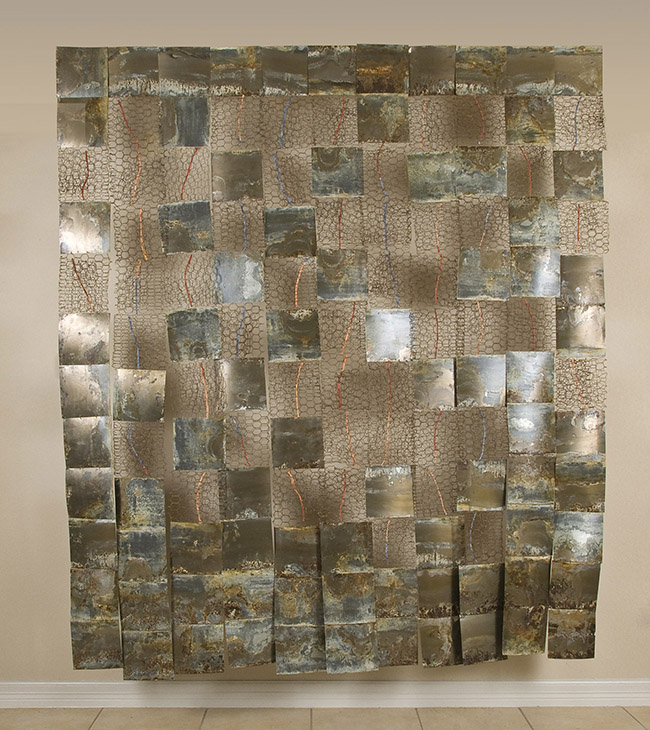Naomi Wanjiku, a Kenyan-American visual artist and sculptor, blends heritage with contemporary creativity in her unique fusion. Based in San Antonio, Texas, Wanjiku has managed to carve a distinct space for herself, blending traditional Kenyan artistry with modern, experimental techniques. Her work is a celebration of both the past and present, highlighting the strength and resilience of her roots while embracing new methods of expression.

Born and raised in Gacharage Village, Kenya, Naomi’s relationship with art started early in life, largely shaped by the influence of her grandmother. It was through her grandmother that she learned the timeless art of weaving and spinning yarn from the migiyo shrub, a practice deeply embedded in Kenyan tradition. This grounding in hands-on craftsmanship fostered in Wanjiku an appreciation for resourcefulness, a quality that continues to shape her work today. In her creations, she marries the tactile knowledge of her youth with modern techniques that give her work an unmistakable edge.
Wanjiku’s art is a reflection of her journey—both personal and cultural. It speaks to the stories of migration, displacement, and survival that have defined her life and the lives of countless others. For her, art is not merely a way of making beautiful things; it is a tool for communication, a means to express the complexity of the human experience, especially when it comes to the experiences of African diaspora and migration.
One of her most recent works, Routes of Migration, exemplifies this beautifully. The installation features textured square mosaics created from sheet metal (locally known as mabati) and poultry wire, both materials that carry significant meaning in her work. The sheet metal, a common material in many Kenyan homes, connects Wanjiku to her homeland, while the poultry wire represents the invisible yet rigid structures that control migration and human movement.
In Routes of Migration, the inclusion of colorful fabric cords woven through the wire highlights the vibrancy of human lives and their journeys. The fabric threads evoke a sense of movement, reminiscent of the torn fragments of cloth that often cling to fences or trees along migration routes—a silent testament to the people who have passed through. The imagery is haunting, speaking to the often-unseen traces of humanity left in the wake of migration.
The poultry wire, with its hexagonal openings, represents both confinement and potential escape. It is a paradox—freedom lies within the confines of the wire’s structure, yet the very same structure keeps one trapped, unable to move beyond its boundaries. This duality is central to Wanjiku’s work, as she explores the tension between the human desire for freedom and the systems that limit movement and opportunity. Her art reflects the struggles of those who face these invisible barriers every day—their resilience and determination to move forward despite the constraints imposed upon them.
Wanjiku’s use of industrial materials, like the stainless-steel wire, contrasts sharply with the delicate, colorful fabric cords. This juxtaposition of strength and fragility mirrors the human spirit—resilient yet vulnerable, capable of both breaking and being broken. The beauty of the work lies in this tension, in the way the materials come together to tell a story of survival, hope, and persistence.
Her work is not just confined to the art world. Her artwork has been displayed at institutions such as the San Antonio Museum of Art, the National Museums of Scotland, and the Museum of Textile in Latvia. Additionally, her sculptures can be found in collections at the Vehbi Koç Foundation Contemporary Art Museum in Turkey, the U.S. Embassy in Nairobi, the World Bank in Ghana, and the Henry B. González Convention Center in San Antonio. Her work addresses issues of migration, identity, and the human condition, resonating across cultures and borders.
Beyond her artistic success, Wanjiku is a testament to the power of education and cultural exchange. She refined her artistic techniques through studies at the University of Nairobi and later at UCLA, where she was able to broaden her understanding of art and its possibilities. Her commitment to growth and innovation is evident in the constant evolution of her craft. Wanjiku’s art is always in flux, always adapting, and always reaching for new ways to express the stories that matter most to her.
Wanjiku’s work challenges viewers to think differently about the spaces and structures that surround them. It asks them to reflect on the consequences of migration, both voluntary and forced, and to consider the forces—social, political, and economic—that shape human movement across the globe. In Routes of Migration, Wanjiku does not just capture the visual elements of migration; she imbues the work with a deep emotional resonance that makes the viewer pause and reflect on the human lives behind the fences, borders, and regulations.
Naomi Wanjiku’s art is a powerful blend of history and modernity, a celebration of her Kenyan heritage, and a profound meditation on the struggles and triumphs of migration. She continues to push the boundaries of artistic expression, proving that art is not only a reflection of society but a catalyst for change. Through her work, she invites us all to reconsider the meaning of freedom, resilience, and the unbreakable human spirit.

